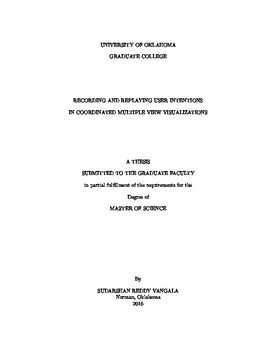| dc.description.abstract | Visualization tools help people gain insights into data. Analysts often want to revisit and review previously visited visualization states to make sense of their previous observations. Browsing a history of visualization interactions is often useful. Traditionally, history mechanisms are based on either undo-redo or replay of low-level keyboard and mouse interactions. In this thesis, we examine the feasibility of translating low-level interactions into high level user intentions for the purpose of recording user actions at a semantic level. Yi, et al. taxonomize low-level interactions into seven higher level user intents: Select, Connect, Encode, Filter, Explore, Reconfigure, and Abstract/Elaborate. Our hypothesis is that a rule-based system can translate low-level mechanical interactions into user intentions under the Yi taxonomy.
Many visualizations are designed around the data state model, in which visualizations are composed of parameters, operators, datasets, and views. Dependencies between these objects define a coordination query graph. When a user interacts with a visualization, these objects get modified in particular sequences to process, render, and display the information. Our core idea is to define rules that map the activity in sets of connected objects in a visualization coordination graph into corresponding user intentions. By dissecting existing visualization designs, we identified and characterized distinct mapping functions for each type of intention. We then collected these functions in a set of rules for deducing user intentions.
Based on the identified mapping functions, we implemented a rule system as a new capability in the Improvise visualization environment, for discerning user intentions behind user interactions. User intentions detected by the rule system are recorded in an automatically generated data set to allow a user to revisit earlier visualization states. We designed a user interface to let the user query the intent data set and restore and replay past visualization states. Finally, we assessed the utility of the system for performing queries and replaying visualization history at the level of intentions. | en_US |
